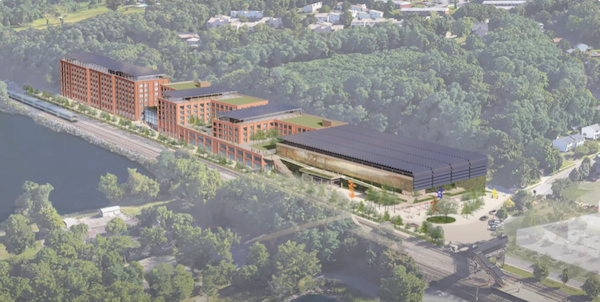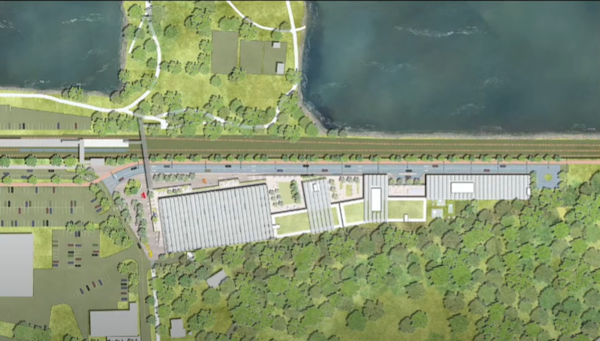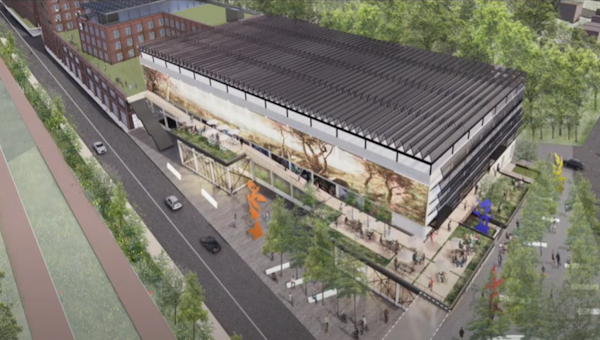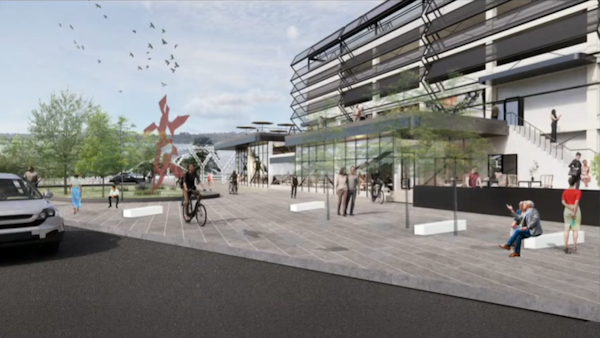Train complex to include housing, retail, parking
The Metropolitan Transportation Authority on Wednesday (July 30) announced that it has selected a developer to transform the Beacon Metro-North station with a complex containing 265 apartments, 15,000 square feet of retail space and a parking garage for 573 vehicles.
Jonathan Rose Companies, a real-estate firm that specializes in the development and management of environmentally sustainable, mixed-income communities, won the bid. It was founded in 1989 by Jonathan F.P. Rose, a Philipstown resident who is a co-founder of the Garrison Institute, a retreat and research center on the grounds of the former Glenclyffe Monastery.

The parking garage will replace 484 commuter and 89 MTA employee spaces on the station’s 41/2-acre north lot. The apartment complex will have 270 spaces for tenants.
The contract will be finalized after the Beacon Planning Board completes an environmental review of the development. The MTA received eight proposals for the project, which was announced in November.
Beacon is “an amazingly vital, creative community” Rose said in a statement. “We are so pleased to have been selected.”
The development will be owned by New York State and leased by the Jonathan Rose Companies. The parking structure, which will be built first and take about a year, will be funded by a $24 million grant from the state’s Redevelopment of Underutilized Sites for Housing program.

Once the parking structure is complete, it will be turned over to the MTA to operate. The residential and retail components will be built next over about two years and be leased and operated by the Jonathan Rose Companies for an initial payment of $669,430 annually. The residential development must conform to Beacon’s zoning by renting at least 10 percent of its units at below-market rates.
Mayor Lee Kyriacou, who attended an MTA Finance Committee meeting on Monday in New York City, called the project a “win-win-win” that would provide environmentally friendly housing, replace impermeable blacktop with shops and waterfront activity and contribute tax revenue to the city.
Without state funding, “it is very, very difficult” to complete transit-oriented developments at suburban stations, said Robair Reichenstein, the vice president of transactions for transit-oriented developments at the MTA. “It’s very expensive to replace that [parking]. This was the reason it happened.”

In 2023, to address an affordable housing crisis, Gov. Kathy Hochul directed agencies to repurpose underused, state-owned sites. The 2025-26 state budget includes $500 million to build up to 15,000 homes on state-owned property, including the Beacon development.
In a statement on Wednesday, Hochul said the Beacon project would revitalize the area surrounding the Metro-North station, “giving more New Yorkers the opportunity to live in a vibrant community with an express train to New York City just next door. This project is a model for how thoughtful development can strengthen communities and make our state more affordable and livable.”
Kyriacou noted that Beacon has come a long way since 2007, when the MTA asked developers to submit “expressions of interest” for projects on 18 acres adjacent to the train station. The city received proposals that included as many as 600 apartments in buildings ranging from two to six stories, along with a parking garage. A citizens’ group, Beacon Deserves Better, opposed the plans.
In the years since, zoning has been revised to open land around the station to residential and commercial development while preserving areas such as Dennings Point and Seeger Riverfront Park. A 2017 update to the comprehensive plan names the east side of the Metro-North station as one of four locations where the densest residential development should occur.

The MTA “had a lot of places it could go to, and they chose here,” said Kyriacou. “That’s a statement about how far Beacon has come and where it’s headed.”
Kyriacou added that he hopes the partnership with the agency will carry over to his “No. 1 priority,” a 13-mile Beacon-to-Hopewell Junction trail that would start at the train station and run along a dormant MTA rail line. Dutchess County is nearly finished with its feasibility study of the proposal, he said.
Neal Zuckerman, a Philipstown resident who represents Putnam County on the MTA Board, noted “there are many communities across the Long Island Rail Road and Metro-North that desperately could benefit by this very thoughtful movement [transit-oriented development]. It is the way we keep young people and older people in this incredibly expensive state and region. It is a way to keep people, so they don’t have to have a car and can take the train to work in the city. I highly recommend that every village, every city, every town look into TOD everywhere we have a station.”
MTA Board Finance Committee Meeting, July 28, 2025


Did New York State even look at their own State Department’s Hudson River flood risk map? Seems like a dumb place to build given future storm frequency, rise in sea level and tidal flooding.
The continued development of Beacon — 20 percent increase in residential units in less than 10 years — without a complete re-writing of the comprehensive plan is foolish. Demands on the local schools, infrastructure and traffic (Route 9D and Beekman, in particular), and the indirect impacts on local businesses, are critical considerations. Have these issues been adequately addressed by the mayor, City Council, Board of Education, state Department of Transportation and the Planning Board?
Careful and considered planning to ensure a safe, walkable city for all age groups and income bands should be the cornerstone of a new comprehensive plan. When the current version was written in 2007, Beacon was not the city it is now.
I support the effort to address our region’s housing shortage — Beacon urgently needs more homes. However, I’m concerned this project doesn’t seem to include a clear plan to improve public transportation alongside the new development.
The recent elimination of the Beacon–Newburgh ferry has reduced a vital transit link, just as more residents are expected to move in. Without investments in alternatives like bus service, bike lanes and pedestrian infrastructure, we risk making Beacon more congested and less livable.
Many communities are finding creative ways to reduce their reliance on private vehicles. Yet here in Beacon, we continue to invest heavily in parking — one of the most inefficient and expensive uses of public land. It’s frustrating to see our town double down on car dependency when better, more equitable options exist.
I was at the Save the Ferry rally and couldn’t help but notice the mayor’s absence. Could he share why he hasn’t been more engaged in preserving or expanding transportation options beyond private cars? It would be encouraging to see leadership that views mobility as a core part of sustainable growth.
Ah, more development! Ka-ching! The real estate/development business is humming right along in Beacon, and our mayor happily succumbs to each idea, regardless of any adverse effects on residents.
The green space along our waterfront is not an “underutilized space,” as the governor puts it — it is utilized by a great many of us. Unlike many Hudson River towns, our waterfront is an escape from human noise. Unfortunately, our mayor and governor have no better use than to sully this area with retail shops, a gigantic parking garage and hundreds of new residents.
Once this green place has been developed, it is gone forever. We can do no better to honor the legacy of Pete and Toshi Seeger, not only by naming a park after them but protecting and preserving this special place.
Albany will ram this through under cover of the summer news cycle, which is a strategy for sure. They did the same thing the last time and have been spending decades setting the legal structure so the governor can move unilaterally. It’s no more than a Metropolitan Transportation Authority cash-in to plug budget gaps, and a nod to developer friends of those in power or who kiss the rings of those in power. We opposed it in 2010 because it would have added hundreds of commuter parking spaces although the main corridor couldn’t — and still can’t — support that traffic, which mostly comes from the other side of the river. The fools endorsing it then promoted it as a community hub with coffee shops, wineshops and such, right in the face of the pioneers of modern Main Street who took the risk with their own money to renovate buildings and start businesses. The project was killed because it was a bad idea, but MTA proceeded to add hundreds of spots anyway, which led to congestion and dangerous conditions in the corridor that leads to westbound bridge traffic. It cannot be resolved by traffic-signal optimization. You’ll be told that the studies show otherwise, but those studies, as far as I know, were not done considering the peak use of the train system that was reached years ago. In my experience, we are not near the peak train ridership of before the pandemic. Ridership is down because of work-from-home and an… Read more »
Any time a project is billed as “environmentally sustainable” my BS radar goes up. Another favorite buzz term of the new urbanists is “transit-oriented development,” aka TOD. The Jonathan Rose Companies was an early adopter of this term, which has a nice ring when sprinkled throughout marketing materials and requests for proposals. The reality is that, while TOD may be effective for large cities, it doesn’t fly in a place like Beacon. Despite being a city, Beacon functions much more like a traditional suburb, albeit one with a lovely old retail district. The development will be near transit, but that transit consists of a single train running to New York City. A true TOD needs a viable network of other, non-automobile transit — some combination of buses, subways and safe bicycle infrastructure. Beacon does not have the critical mass for this type of network. Look at the virtually empty buses driving down Main Street and the recently canceled ferry service. This project is an example of “transit-adjacent” development. In other words, a bunch of apartments and retail space built next to a train station. The article cites an MTA board member: “It is a way to keep people, so they don’t have to have a car and can take the train to work in the city.” If that is the case, why is the first structure a parking garage for all the spaces that will be sacrificed for the project, along with an additional 270 spaces for the new units?… Read more »
This development should not surprise anybody. When I moved to Beacon in 2014, this was openly discussed as the plan for that enormous northern parking lot. [via Facebook]
Where will commuters park during the one-year construction of the parking garage? Commuter parking in Beacon is busting at the seams, and many drive to Cold Spring. I am curious to see a study that forecasts parking needs. [via Facebook]
We don’t need more development, especially when the so-called “affordable housing” is not affordable for many people. Go to meetings, voice your opinion and contact your representatives. They have already ruined our little city. [via Facebook]
Does the Planning Board have the power to stop these projects? Or is Beacon trying to add residents? It seems reckless to just approve every project that’s brick with black detailing. [via Instagram]
The MTA continues to charge our communities more while offering less in return. If we’re going to add hundreds of new housing units near the Beacon train station, restoring the Newburgh-Beacon ferry should be part of the plan because reliable and expanded transit options benefit everyone — from local commuters to tourists to small businesses.
It makes sense to explore ways that revenue from this project can be reinvested in our communities to support transportation services people will use. Residents deserve to know the MTA will benefit from this project.
Rolison is a state senator whose district includes the Highlands.
Are they still going to make our overworked postal workers truck all our mail across the river multiple times a day? More people, more mail. Give them a properly equipped facility. [via Facebook]